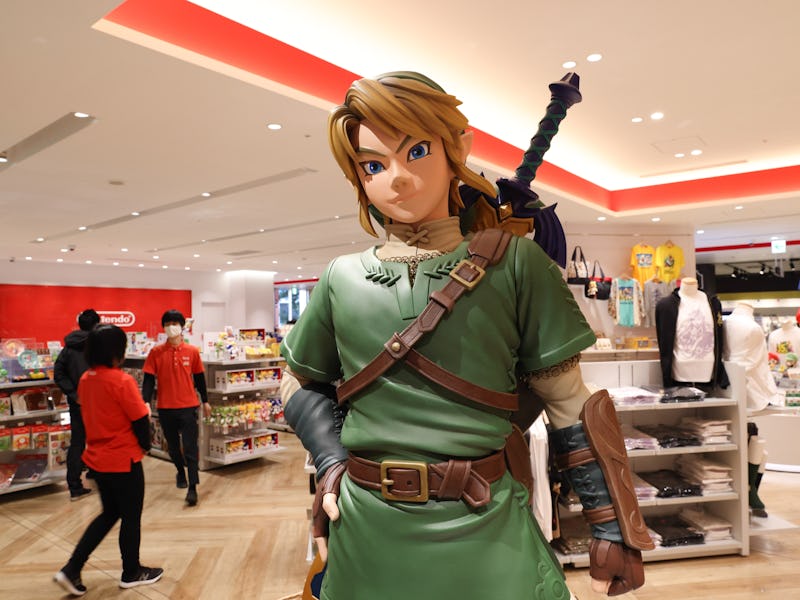The First Portable Zelda Game Was Not What You Think
A pocketful of potential.

Idle hands are the devil’s workshop. This old aphorism points to what is now the central pillar of our lives: boredom sucks. Staying busy seems the obvious remedy to boredom, but we often conflate busy with productivity because capitalism. “Productive” is better than “bored,” but still isn't “fun.” Video games are fun, and in 1980 Gunpei Yokoi, a brilliant Nintendo engineer who eventually designed the Game Boy, was inspired by a Herculean display of anti-boredom fun on a commuter train. He saw a fellow salaryman idly mashing his calculator and realized that if the millions of humans on the go every day get so bored they’re willing to play calculator masher, then a portable video game would captivate them (and their wallets). Thus, Nintendo’s Game & Watch was born.
Of course, Yokoi didn’t invent portable games. As early as 1977, there were lots of basic handhelds, especially for card games. But none were as dynamic as Yokoi’s Game & Watch because none were backed by Nintendo’s legacy characters. The company released dozens of Game & Watch units in the ‘80s, culminating in its penultimate release on August 26, 1989: Zelda. Based on the breakout NES RPG, the Game & Watch version offered an authentic, if limited, gaming experience that paved the way for even bigger things.
The Zelda Game & Watch was part of the “Multi Screen” series, which featured two LCD screens that opened like a clamshell, similar to a compact version of the Nintendo DS. This design allowed for more complex gameplay than earlier single-screen models and made it possible to recreate some of the adventure elements of The Legend of Zelda in a portable format.
The game was played across two screens. The top screen depicted the overworld, while the bottom screen represented the dungeons. Players control Link on a quest to reclaim eight pieces of Triforce from some evil dragons. The gameplay involves Link hacking his way through enemies on the right side of the screen while skeletons try to stab him from underneath the platform. It’s more challenging than it sounds and the difficulty ramps up quickly with only a limited window to successfully attack your foe before you have to switch positions.
While it’s not gonna win any DICE awards for looks, the gameplay depth was groundbreaking for its day.
One of the standout features was the inclusion of a life bar, a first for the series. In earlier Game & Watch titles, players typically had only one or two lives before the game was over. However, in Zelda, players had multiple hearts, which added a layer of strategy to the game. You gained a health point for completing a level and, similar to the console versions, Link could fire projectiles from his sword if you reached the five-heart max health, which was a huge advantage.
While the Zelda Game & Watch was a departure from the full-fledged Zelda games on the NES, it was still a notable entry in the series for several reasons. First, it was an early attempt to bring the franchise to a portable format, something that would become increasingly important with the Game Boy, which actually released four months earlier on April 21, 1989 but didn’t see a Zelda title until Link’s Awakening dropped in 1993.
The game also demonstrated Nintendo's ability to adapt its popular franchises to different formats and technologies. By 1989, The Legend of Zelda was a key franchise for Nintendo, and its appearance on the Game & Watch demonstrated Nintendo’s willingness to put it on the same level as Mario or Donkey Kong. It was also a cutting-edge piece of tech, even if it doesn’t look it by today’s standards. The Multi Screen design, which would later influence the Nintendo DS, the 3DS, and the Wii U, allowed for a more immersive and engaging experience than earlier single-screen Game & Watch games.
The 2021 Game & Watch Anniversary Edition was a nice nod to Yokoi’s original inspiration (even though the game wasn’t included in the lineup).
Today, the Zelda Game & Watch is a coveted piece of nostalgia for collectors. Its rarity, especially with the box and instruction manual, combined with its significance as part of the Zelda franchise and the Game & Watch series makes it go for as high as $500 on eBay. Nintendo also resurrected the Game & Watch to celebrate The Legend of Zelda's 35th anniversary in 2021. This upgraded version features a bright LCD screen and fully playable versions of both NES games and Link’s Awakening.
For fans of The Legend of Zelda, the 1989 Game & Watch version represents a fascinating piece of history. It stands as a testament to Nintendo's creativity and innovation at a time when the company was still exploring the potential of handheld gaming. While it may not offer the same depth and complexity as the mainline Zelda titles, it remains an important part of the franchise's legacy. Idle hands don’t stand a chance.